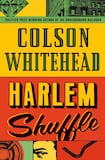
“All over the city there were people like them, a whole mean army of schemers and nocturnal masterminds working their rackets.” Colson Whitehead’s new novel takes place in the criminal underworld of 1960s Harlem, adding yet another historical era and genre to the New York writer’s diverse back catalogue.
In recent years Whitehead has had huge success, firstly with The Underground Railroad (2016), which won the National Book Award, the Pulitzer Prize for Fiction, The Arthur C Clarke Award for Fiction and the Andrew Carnegie Medal for Excellence; and latterly with 2019's The Nickel Boys, which also won a Pulitzer – making him one of only four authors to have two – the George Orwell Prize for Political Fiction, and a longlisting for the Booker Prize.
Both novels looked at racial injustice in the US at a specific time. The Underground Railroad told the story of two slaves, Cora and Caesar, who escape from a Georgia plantation and try to make their way north through the titular railroad, a secret transport system with safe houses and saviours along the way. The Nickel Boys was also about secrets, the terrible wrongs of Jim Crow-era Florida that lay buried in a graveyard of a prison reform school.
Ray Carney, the protagonist of Harlem Shuffle, has more agency than the characters of these earlier books, but secrecy is still a fundamental part of how he lives or, some might say, survives. By his own admission, here is a man “only slightly bent when it came to being crooked”.
Diligent and pragmatic, Carney has survived his tough upbringing (poverty, a drug-addicted father, orphaned as a teen) and gone on to earn a business degree from Queens College, marry into a middle-class family and establish his own furniture business on 125th Street.
The first of the three sections (1959, 1961 and 1964) gives a fine introduction to this self-made man, getting the reader on board with his wheeling and dealing. Unbeknownst to his wife, Elizabeth, Carney has a sideline connecting his dodgy cousin Freddie with reputable businesses who flip the latter’s stolen goods. In a cleverly structured narrative, this is the petty criminal behaviour that will lead to murkier deals. The book in a nutshell: one averagely honourable man’s incremental descent into criminality.
There is a Dickensian feel to the numerous side characters, a cast of thieves, gangsters, prostitutes, people typically maligned by society, who are given a more dignified turn through Whitehead's lens
In 1960s Harlem, a place where everyone seems to be on the make, there is a fine line between upright and underworld. It’s easy to root for Carney, a man battling against prejudice, against circumstances, against the white police force who are mostly bent themselves, even against his own in-laws, Leland and Alma, two snobbish social climbers brilliantly brought to life: “Race-conscious and proud, up to a point – light enough to pass for white, but a little too eager to remind you that they could pass for white.”
As with his previous books, Whitehead explores whether a person can escape the past, both political and personal. Early in the narrative Carney believes that “living taught you that you didn’t have to live the way you’d been taught to live”. In the final section, set against the backdrop of the 1964 race riots, this view has proven idealistic.
The criminal capers along the way make for an action-packed read. From a heist in the Hotel Theresa, “the Waldorf of Harlem”, to a lesson in how to spot fake jewels, to a blackmail plot involving a rich and publicly revered black man, the shakedowns are entertaining, original and brightly rendered.
Whitehead is a stylish writer, with a great ear for the dialogue of the time. Carney’s voice is by turns commanding and charming: “‘I may be broke sometimes, but I ain’t crooked,’ he said to himself. Although, he had to admit, perhaps he was.”
Sixties Harlem is also captured, from its bustling streets and businesses to its drug dens, people working hard, or living hard: “Everyone who came uptown had crossed some variety of violent ocean.” There is a Dickensian feel to the numerous side characters we meet along the way, a cast of thieves, gangsters, prostitutes, people typically maligned by society, who are given a more dignified turn through Whitehead’s lens.
At times the pages feel too populous, with characters whizzing by, their back stories given in snippets. This is particularly true of the third section. The heist itself is intriguing – an inside job, a member of a rich, well-known family turning on its own – but things get messy as scenes loop back on each other and previous crimes come to the fore.
It is Carney who keeps us interested, his fortunes and misfortunes, a man who lives by his wits on the fringes of two very different worlds, or as he puts it himself in his brutally cheerful way: “Black people always found a way in the most miserable circumstance. If we didn’t, we’d have been exterminated by the white man long ago.”












